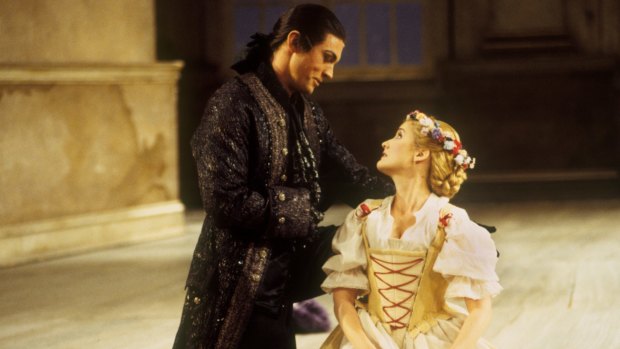This was published 8 years ago
Canberra International Music Festival director Roland Peelman on theatre in music
The artistic director of the Canberra International Music Festival, Roland Peelman, says the advent of opera in 1600 brought music and theatre together like never before.
By Roland Peelman
ON THEATRE IN MUSIC
CANBERRA INTERNATIONAL MUSIC FESTIVAL

Teddy Tahu-Rodes and Taryn Fiebig in Don Giovanni (Opera Australia).
Battle of the Sexes: Three Delicious Moments in Opera's History
Friday, May 6, 7.30pm
Fitters' Workshop
Featuring Marco Beasley, Taryn Fiebig, David Greco and the Festival Ensemble.
When a string is divided in two, a new note is produced above the fundamental tone, exactly an octave higher. They often blend so well, you may not even notice.
Pythagoras drew our attention to this simple natural phenomenon 2500 years ago. More recent discoveries have unlocked the secrets behind the binary processes inside our brain, the way they define human intelligence or the workings of our computers. Genetically disposed to see the world in two parts (north and south, rich and poor, water and land), we similarly love to pinpoint a defining moment in our history that clarifies our own position: Columbus setting foot on American soil in 1492 or the march on the Bastille and the subsequent sharpening of the guillotine in 1789.
For example, the birth of opera in northern Italy about 1600 is a phenomenon that has similarly divided many a musical history book into two: before and after. Sure enough, something new was brewing. Monteverdi called it the "seconda prattica" or "second practise" as distinct from the old church-like polyphonic ways. In the preface to his Eighth Book of Madrigals (which contains the Combattimento featured in the festival's Battle of the Sexes, he calls it the "stile rappresentativo", the need for music to "represent", that is, to reflect the letter and spirit of the text and fuse music with drama and movement.
Opera, particularly once the burghers of Venice made it their own preferred form of entertainment, forced music to adopt a more overtly theatrical style. Either by wallowing in virtuosic showmanship (the cult of the long-limbed castrati), or by reinventing the twists and turns of hard won "rhetorica", a dynamic and direct relationship between performer and audience was forged. You might well say that theatre and music had always been willing bed partners and that the rolling hexameters of the oldest epics in Western civilisation were once sung by a mythical bard called Homer. Indeed, music does not exist without performance. It needs charismatic, divinely gifted musicians to take up Orpheus' lyre again and again.
Three thousand years after Homer, driven by the digital revolution and a 24/7 media cult, society has become another incarnation of Shakespeare's dictum "All the world's a stage". We now find ourselves in a continuous theatre of Everyman's trivially contrived reality. Late-night yawns are as much part of the performance as early morning bathroom routines. A dog doing a dance routine on hind legs can create a Facebook following overnight. So, in this day and age, how do you explain the difference between a violinist with colourful stage histrionics and a circus clown with uncanny ability on the trombone? Paganini's devilish podium demeanour and Liszt's fay but grand gesticulations in the 19th-century concert halls paved the way for musical spectacle that wouldn't just please the ear but also excite all the other senses. The magnetism exuding from the great romantic virtuosi must have been every bit as overwhelming as the teenage hysteria that welcomed the Beatles in Australia.
Great artists make you watch and listen. When we are in the presence of that indefinable quality that hints at alchemy, even forbidden substances, we might close our eyes and blissfully drift away. But closing our ears would be more difficult. Imagine yourself in the early days of opera, long before electric power made everything visible, listening to the trotting of the horses and the clattering of the weapons in Monteverdi's Combattimento, clever sophisticated string innovations they were. But it would mean nothing if it wasn't for the dramatic framework. The story is simple enough, a celebrated episode from Tasso's crusader epic: Tancredi, a Christian knight, falls in love with Clorinda, an Arab princess. Being in opposing camps and concealed in full armour, they engage in combat during which Tancredi fatally wounds Clorinda.
The composer sets up a double device: a narrator who in as lively a fashion as possible paints the action in words and music, versus the action of the protagonists themselves. Either level can be perceived as foreground or background, the narration as voice-over in modern cinema terms or as "singing head" a la Alan Bennett. The tragic fight between Tancredi and Clorinda can be seen and heard as realistic action or as a dramatic shadow of the narration we are told. It is as if Monteverdi sensed the eternal ambiguity between music, which needs a live performer to exist at all, and theatre, which by definition requires the presence of an audience as a sounding board. We can close our eyes and hear the play unfold or we can observe and emphasise with the narrator's skill and compassion. He becomes our interlocutor, the person who looks us in the eye and invites us inside the tableau to become active participants in a pity tale.
Roland Peelman is artistic director of the Canberra International Music Festival. The festival runs from April 28 to May 8.